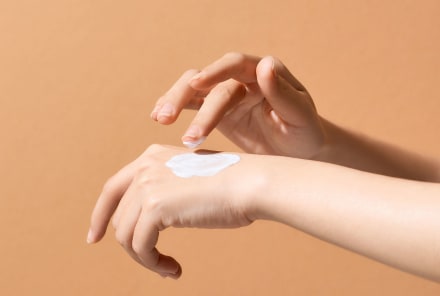Advertisement
Deodorant Rash: 3 Reasons Your Stick Is Messing With Your Pits & What To Do About It


Maybe it's happened to you: You are testing out a new deodorant, and within a few days the area develops a rash. If you're lucky, you might experience slight redness or maybe even tingling upon application. At worst, you may experience burning, inflammation, peeling, and hyperpigmentation. Regardless, this all sounds, uh, not great.
First things first: Stop using whatever new deodorant you're testing out. Clearly, this isn't the outcome you're looking for. But beyond that, an armpit rash might be telling you that you're sensitive to certain common ingredients in deodorant. Here, what your armpit rash is trying to tell you.
Why do deodorants cause rashes?
It's a delicate area, and it's actually quite common for people to have unique sensitives there that perhaps you may not find as irritating elsewhere. "The skin in the axilla is very thin and will notice and react to a larger array of ingredients than other parts of the body," says Nava Greenfield, M.D., of Schweiger Dermatology Group in NYC. "The arms, for example, are less prone to sensitivities."
But as for the rash, what exactly is it? Well, it's usually one of two things: "It can either be an allergy to an ingredient in the product or an irritant reaction to one of the ingredients," she says. These, however, tend to look very similar so it's not always easy to figure out what your rash is indicating.
An allergic reaction is an inflammatory response in the skin and might have to be sussed out by a doctor or dermatologist, who will conduct a test. An irritation (sometimes called contact dermatitis) is usually the lesser of the two and is the result of repeated exposure to an irritating ingredient. If your rash is persistent, and you can't seem to figure out the triggers, consult a derm.
However, here are some of the most common allergens and irritants to look out for:
Certain preservatives
When you hear "preservatives in deodorants," parabens and triclosan likely come to mind. Yet, even most mainstream and traditional deodorant brands have stopped using them in their formulas. But that doesn't mean there aren't still issues with the preservative systems in our cosmetics.
Still more common in traditional deodorants or antiperspirants but common irritants are "the formaldehyde preservatives or formaldehyde-releasing preservatives," says Greenfield. The common culprits are quaternium-15, DMDM hydantoin, imidazolidinyl urea, diazolidinyl urea, polyoxymethylene urea, sodium hydroxymethylglycinate, bromopol, and glyoxal.
Baking soda
Baking soda's cause of irritation actually has to do with pH: Baking soda has a very basic pH, but your armpits (and, well, skin in general) is slightly acidic. Now, normally this is done on purpose: The idea is that when you increase the pH in the area, it will make an inhospitable environment for odor-causing bacteria. (As a very quick reminder, the reason for B.O. in the first place is because an enzyme in certain strains of bacteria interacts with your perspiration, resulting in a pungent smell.) Now, for some people, this causes no issue. For others, the change in pH (and therefore the skin microbiome) will cause a reaction.
Fragrances and essential oils
Fragrances (natural or synthetic) as well as essential oils can in some cases trigger reactions. Some have a reaction to only certain scents (like, for example, you could be allergic to lavender and therefore can't wear any naturally lavender-scented deodorant). Now, fragrances can be volatile molecules, so they often need stabilizers; many of the natural companies have found plant-derived, gentle options—but if you are still using more traditional deodorants, you may also be reacting to the stabilizers. (Read: It may not be the fragrance molecules itself but instead the ingredients used to keep them smelling fresh.)
Essential oils, given they are highly concentrated doses of oil extracted from botanicals, can be too irritating given their potency. Or, depending on what plant they are extracted from, some may actually be allergic to a specific essential oil.
Finally, you may just find fragrance in general to be too bothersome sensorily.
What can you do about a deodorant rash?
Usually, deodorant rashes can be self-medicated and are not cause for alarm. Obviously, as we've noted before, cease use of the deodorant once you start to notice discomfort or discoloration. You can apply a soothing cream or gel to temper inflammation and hydrate the area (see our list below), but ultimately, it may just take some time for it to fade: "Allergic or irritant rashes typically take about two weeks to fully resolve," says Greenfield.
- Aloe vera
- Colloidal oatmeal
- Hypoallergenic creams
- Cool compresses
Now, if you find that it is serious (read: you're in consistent pain or the skin is fairly raw), you'll need to see the doctor. "Sometimes an area needs prescription medication for it to resolve in order to address the increase in inflammatory cells in the skin due to the reaction," says Greenfield.
Finding the right option for you.
Don't worry; there are plenty of options to choose from. First up, if you're new to the natural deodorant world and you're reading this story because you suspect some of your irritation is from traditional preservatives, here's a good list of natural deodorants to start with. Now, if you suspect that your skin irritant is baking soda, you can find a plethora of baking-soda-free alternatives in the natural market too. As for fragrance and essential-oil-free, most brands offer options that don't include scent—or opt for a crystal deodorant.
The takeaway.
Rashes are actually quite common in the area. If it happens to you, stop using it immediately and try to suss out the irritant at hand. If all else fails, simply find a deodorant formulated for sensitive skin, sans baking soda, preservatives, and fragrances or essential oils.











